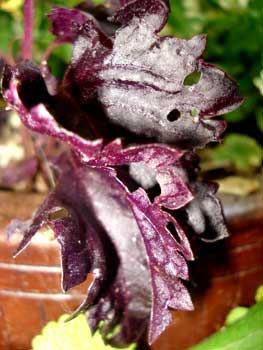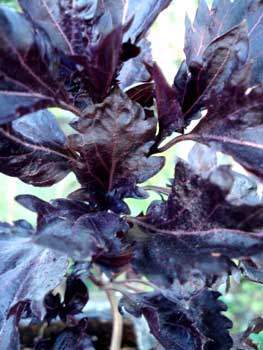
'Purple Ruffles' Basil
"With basil then I will begin
Whose scent is wondrous pleasing."
-Michael Drayton,
1612
I try to resist adding Ocinum basilicum var purpurascens 'Purple Ruffles' when I'm preparing the annual culinary garden just outside the kitchen door.1612
For me, at least, on the occasions I've included it to the varieties of basils & other herbs, it is always the slowest to produce leaves, with the least harvestability through most of summer long. I end up trimming leaves from every other herb & letting the ruffled basil be more decorative than useful, as it doesn't replace its leaves nearly fast enough.
 It's ornamental powers, though, are sufficient that I cannot always resist it, even if it will not feed me as much as every other basils I've grown. It has big purple flowers if you just give up on it for food production.
It's ornamental powers, though, are sufficient that I cannot always resist it, even if it will not feed me as much as every other basils I've grown. It has big purple flowers if you just give up on it for food production.This year, though, I pinched off the buds & did what I could to see if I couldn't induce it to produce more leaves. Compared to the regular purple basil right next to it, & the Thai basil & the green sweet basil, Purple Ruffles just doesn't produce.
It's frequently called a "midseason basil" for developing a later than, say, 'Genovese' large-leaf basil which bushes up early & replaces its harvested leaves quickly. I'd call it "late season" but then I'm impatient.
Eventually it grows to sixteen inches to two feet high & nearly as wide. If ignored until August it'll eventually be big enough to take a lot more trimming for kitchen use, but it goes no longer into autumn than 'Genovese' or 'Red Rubin' or 'Thai Basil,' so it serves no special function by getting going so much later.
For flavor it is very pleasant, though not noticeably distinct from 'Red Rubin' opal basil which has the same mahagony-purple leaf color but without the ruffled edges. If eaten raw, however, 'Red Rubin' is a tougher leaf than either the green sweet basil or 'Purple Ruffles,' so the ruffled is a better salad basil than the Rubin. It's also a favorite for herb vinegar & herb oil, both for color & delicate slant toward clove-and-licorice taste.
Ruffled basil sometimes reverts to green as the summer progresses, the purple being not as stable as in 'Red Rubin,' though in hottest days of summer in brightest light even 'Red Rubin' can fade out toward green.
Sometimes this tendency can be held at bay by harvesting the reverted leaves as they appear & only letting the purple leaves mature, but if the given plant decides it only wants to produce green leaves after its first richly mahogany flourish of foliage, then you just have be grateful it at least tastes good.
An easy drying method, for the sake of winter basil, involves tying up a bundle of leaves on their stems & sealing them in a brown paperback with the bottoms of the stems sticking out & the leaves dangling inside the bag. It'll lose moisture through the exposed stems while keeping the leaves fresh as can be. Allow them to dry out for three or four weeks.
When you take them out of the bag they'll be dry & brittle. Store them in a cool dark cupboard in a lidded Rubbermaid type container, & don't crumble the leaves until the moment of use.
I once heard a chef, in self-important intonation, insist no real cook would have dried herbs in their kitchen, but only fresh. That struck me as nonsensical. The dried basil will have a stronger rather than weaker flavor, different than fresh but just as good.
A flavorful red pesto can also be a delight, though it may be necessary to mix in some 'Red Rubin' unless you've planted a lot of ruffled basil, a mere couple of plants not producing enough leaves. Be imaginative with pesto recipes. Start with one or two large minced cloves of garlic, a half-cup of olive oil, a mixed half-cup of fresh-grated romano & parmesan cheeses, a quarter-cup of pine-nuts, & two cups of basil.
That's the basics. Then consider various personal choice additions: a fourth of a cup of walnuts instead of pine nuts (or a mixture); or add chopped up dried tomatoes; one medium-sized grated carrot; a teaspoon of dill & fresh-ground multicolor peppercorns; a mere whisper of powdered clove to enhance that side of the Purple Ruffles flavor, or an equally tiny dash of allspice, or nutmeg, or cinnamon, or star-anise but never go overboard. You can even move it toward the cooking of India rather than of Italy by putting in just a little curry powder.
Continue to:
'Genovese' Italian Largeleaf Sweet Basil